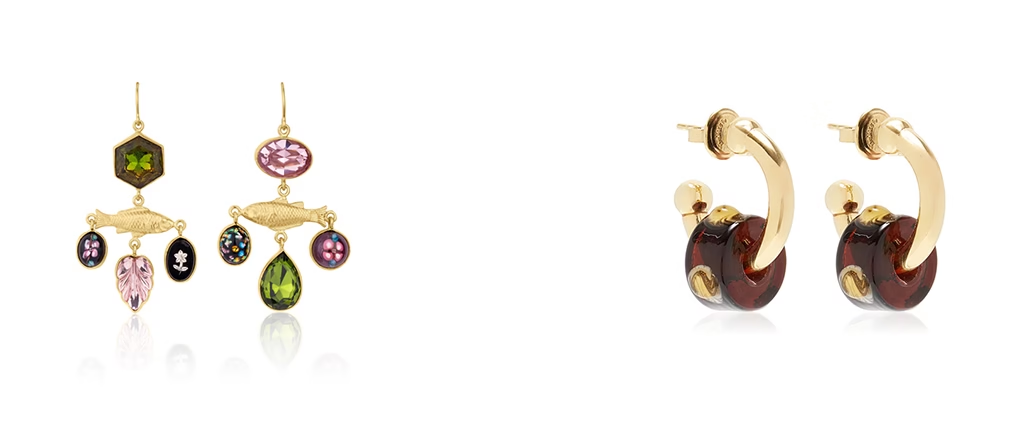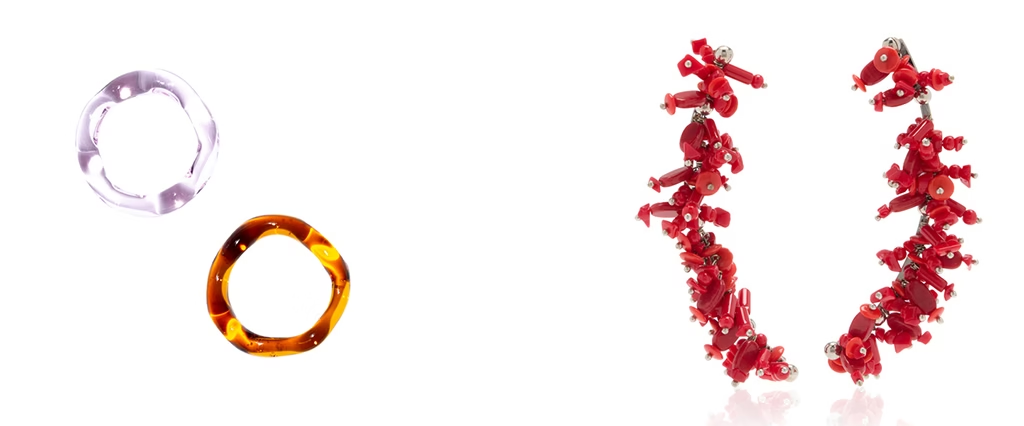When envisioning fine jewelry, the mind instinctively conjures images of scintillating diamonds, vibrant colored gems, and the gleaming allure of precious metals. But a surprising material, long relegated to the world of costume pieces and whimsical trinkets, is making a bold and captivating entrance into the high-fashion vernacular: glass. Jewelry designers are now wholeheartedly embracing glass for its boundless creativity, celebrating its capacity for abstract shapes, its spectrum of rich, luminous colors, and its unexpected versatility. Some artisans masterfully combine it with traditional stones or metals for a dynamic play on texture and color, while others allow the glass to stand entirely on its own, a testament to its inherent beauty.
This burgeoning trend signifies more than a mere shift in materials; it speaks to a larger, more profound movement within the realms of fashion and design. The ascent of glass in fine jewelry mirrors the free-spirited, “boho-luxe” aesthetic that continues to captivate the style landscape, championing individuality, artistry, and a joyful approach to personal adornment.
A Luminous Legacy: The Enduring History of Glass in Jewelry
While its current popularity feels fresh and modern, the use of glass in jewelry is a practice steeped in ancient history. This is not so much a new trend as it is a renaissance, a rediscovery of a medium that has fascinated artisans for millennia.
Ancient Origins and Venetian Mastery
The story of glass in personal adornment begins in antiquity. The earliest known glass objects were beads, dating back to Mesopotamia and ancient Egypt around 1500 BCE, where glass was first created to mimic precious stones like lapis lazuli and turquoise. These early creations were considered as valuable as their gemstone counterparts. The Roman Empire later perfected techniques like “millefiori”—Italian for “a thousand flowers”—which involves fusing patterned glass canes to create intricate designs that remain popular today.
However, it was during the Renaissance that Venetian glassmakers on the island of Murano became the undisputed masters of the craft. To guard their valuable trade secrets and mitigate the risk of fires in the city of Venice, all glass furnaces were moved to Murano by law in 1291. Here, artisans developed revolutionary techniques, creating cristallo, an almost transparent glass considered the finest in the world, and lattimo, a milky white glass that resembled porcelain. Murano glass beads became so prized they were even used as a form of currency in trade with Africa and the Americas.

The Modern Renaissance: Why Glass is Captivating the Jewelry World Now
The resurgence of glass in high-end jewelry is driven by a confluence of contemporary cultural shifts and a renewed appreciation for its artistic potential. It’s a material that perfectly aligns with the modern desire for authenticity, self-expression, and sustainable choices.
The Allure of the “Boho-Luxe” and Joyful Expression
The free-spirited, “boho-luxe” aesthetic is defined by a blend of bohemian artistry with luxurious, high-quality materials. It favors pieces that are unique, handcrafted, and tell a story. Glass jewelry, with its infinite variations in color, shape, and texture, fits seamlessly into this ethos. It allows for a level of personalization and artistic expression that can be more difficult to achieve with traditional gemstones. This trend also ties into the concept of “dopamine dressing”—choosing to wear things that bring joy and boost one’s mood. The vibrant, candy-colored glass rings and kaleidoscopic pendants that are gaining popularity are a direct reflection of this desire for playful, uplifting adornment.
A Medium of Infinite Possibility and Sustainable Style
Unlike the rigid structures of faceted gemstones, glass offers a fluid and adaptable medium for designers. It can be blown, fused, lampworked, or cast, allowing for an incredible range of forms, from delicate, organic shapes to bold, architectural statements. This versatility is a playground for creative minds.
Furthermore, as consumers become more conscious of their environmental impact, glass presents a more sustainable option. Some designers, like the founders of the Toronto-based brand Par Ici, specifically seek out deadstock and vintage glass, repurposing forgotten materials from decades past to create new, beautiful pieces and reduce waste in the fashion industry. Other small businesses, like Cled, specialize in creating jewelry from discarded glass bottles.

Masters of the Medium: The Designers Defining Glass Jewelry
A new wave of innovative designers is pushing the boundaries of what glass can be in the world of fine jewelry. They are the vanguards of this “glass renaissance,” each bringing a unique vision to the craft.
Brinker + Eliza: Vintage Inspiration, Modern Heirlooms
The mother-daughter duo behind Brinker + Eliza handcrafts statement jewelry that feels both timeless and fun. They are particularly known for their use of millefiori glass beads, often sourced from vintage Venetian collections. Their “Higher Love” necklace, featuring colorful glass heart beads on a 24k antique gold-plated chain, perfectly encapsulates their brand ethos: creating playful, yet elegant pieces that are made to be loved and passed down. They often mix these vibrant glass elements with freshwater pearls and other semi-precious stones, creating a rich tapestry of textures and colors.
Studio Conchita and the Power of Borosilicate
Showcasing the more modern and technical side of glass jewelry, Studio Conchita utilizes borosilicate glass for its striking rings and accessories. Borosilicate is a type of glass known for its exceptional durability and resistance to thermal shock—it’s the same material used in laboratory equipment and high-end cookware like Pyrex. In jewelry, these properties are a significant advantage. Borosilicate glass is surprisingly lightweight, allowing designers to create larger, more sculptural pieces that remain comfortable to wear. Its strength also ensures that these artistic creations are built to last.
The Sculptural Artistry of Lampworking
Lampworking, also known as flameworking, is a technique where an artist uses a torch to melt and manipulate rods of glass, often winding the molten glass around a coated steel rod called a mandrel to form beads. This method allows for incredible detail and sculptural quality. Artists like Darleen Nixon of Nixon Art Glass create intricate pieces by sculpting glass over a torch at around 1800 degrees. The process requires incredibly steady hands and a deep understanding of how different colors and types of glass will behave in the flame. This technique can produce everything from simple, elegant beads to complex, lifelike floral and animal forms.
The Painterly Effects of Fused Glass
Another technique gaining prominence is fused glass, where artists cut and layer different colors and types of compatible glass and then melt them together in a kiln. This process can create stunning, painterly effects, with colors that blend and flow like watercolors or form sharp, geometric patterns. Artists who work with fused glass can create flat, pendant-style pieces or “slump” the glass in a second firing to create three-dimensional forms like bowls or, for jewelry, curved components. Husband and wife team Shimmering Glass are among the artists who use this technique to create everything from jewelry to larger art pieces.
Embracing the Future of Fine Jewelry
The re-emergence of glass as a treasured material in fine jewelry marks a significant and exciting shift in the industry. It signals a move away from traditional notions of value being tied solely to rarity and price, and a move towards a celebration of artistry, innovation, and personal expression. From the storied workshops of Murano to the modern studios of Brooklyn and beyond, designers are proving that the creative potential of glass is as clear and boundless as the material itself. This is not a fleeting trend, but a vibrant new chapter in the long and luminous history of adornment.



